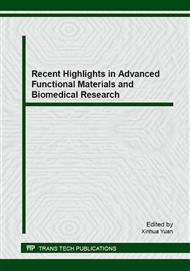[1]
Kim J, Lee H, Lee Y, Inhibition effects of Moutan Cortex Radicis on secretion of eotaxin in A549 human epithelial cells and eosinophil migration, J Ethnopharmacol. 114 (2007) 186-193.
DOI: 10.1016/j.jep.2007.07.038
Google Scholar
[2]
Du Q, Feng G, Shen L, Paeonol attenuates airway inflammation and hyperresponsiveness in a murine model of ovalbumin-induced asthma, Can J Physiol Pharmacol. 88 (2013) 1010-1016.
DOI: 10.1139/y10-077
Google Scholar
[3]
Kim SH, Kim SA, Park MK, Paeonol inhibits anaphylactic reaction by regulating histamine and TNF-alpha, Int Immunopharmacol. 4 (2008) 279-287.
DOI: 10.1016/j.intimp.2003.12.013
Google Scholar
[4]
Chou TC, Anti-inflammatory and analgestic effects of paeonol in carrageenan-evoked thermal hyperalgesia, Br J Pharmacol. 139 (2007) 1142-1144.
DOI: 10.1038/sj.bjp.0705360
Google Scholar
[5]
Wu M, Gu Z, Screening of bioactive compound from moutan cortex and their anti-inflammation activities in rat synoviocytes, Evid Based Complement Altemat Med. 6 (2006) 50-54.
Google Scholar
[6]
Li YJ, Bao JX, Xu JW, Vascular dilation by paeonol- a mechanism study, Vascul Pharmacol. 53 (2010) 158-160.
Google Scholar
[7]
Ma YU, Bates S, Gurney AM, The effects of paeonol on the electrophysiological properties of cardiac ventricular myocytes, Eur J Pharmacol. 545 (2006) 86-89.
DOI: 10.1016/j.ejphar.2006.06.064
Google Scholar
[8]
Li H, Dai M, Jia W, Paeonol attenuates high-fat-diet-induced atherosclerosis in rabbits by anti-inflammatory activity, Planta Med. 75 (2008) 63-66.
DOI: 10.1055/s-0028-1088332
Google Scholar
[9]
Nizamutdinova IT, Jin YC, Kim JS, Paeonol and paeoniflorin, the main active principles of Paeonia albiflora, protect the heart from myocardial ischemia/reperfusion injury in rats, Planta Med. 74 (2012) 17-20.
DOI: 10.1055/s-2007-993775
Google Scholar
[10]
Koo YK, Kim JM, Koo JY, Platelet anti-aggregatory and blood anti-coagulant effects of compounds isolated from Paeonia lactiflora and Paeonia suffruticosa, Pharmazie. 65 (2011) 624-627.
Google Scholar
[11]
Su SY, Chcng CY, Tsxi TH, Paeonol attenuates H2O2-induced NF-KB-associated amyloid precursor protein expression, Am J ChinMed. 36 (2010) 1161-1164.
Google Scholar
[12]
Zhong SZ, Gc QH, Qu R, Paeonol attenuate neurotoxicity and ameliorates cognitive impairment induced by d-galactose in ICR mice, T Ncurol Sci. 275 (2009) 55-59.
Google Scholar
[13]
Li N, Fan LL, Sun GP, Paeonol inhibits tumor growth in gastric cancer in vitro and in vivo, World J Gastroenterol. 35 (2010) 4475-4479.
Google Scholar
[14]
Sun GP, Wing H, Xu SP, Anti-tumor effects of paeonol in a HepA-hepatoma bearing mouse model via induction of tumor cell apoptosis and stimulation of IL-2 and TNF-alpha production, Eur J Pharmaco1. 582 (2008) 247-250.
DOI: 10.1016/j.ejphar.2008.02.016
Google Scholar
[15]
Tan S, Yc J, Qixn C, Paeonol inhibits the proliferation of human colorectal carcinoma cells and synergic with chemothera-peutic agents, Saudi Med J. 28 (2012) 642-643.
Google Scholar
[16]
Lee HJ, Kim SA, Jeong SJ, Paeonol oxime inhibits bFGF-induced angiogenesis and reduce VEGF levels in fibrosarcoma cells, PloS One. 5 (2010) e12358.
DOI: 10.1371/journal.pone.0012358
Google Scholar
[17]
Kim SA, Lee HJ, Ann KS, Paeonol exerts anti-angiogenic and anti-metastatic activities through down-modulation of Akt activation and inactivation of matrix mctalloproteinases, Biol Pharm Bull. 32 (2009) 114-1147.
DOI: 10.1248/bpb.32.1142
Google Scholar
[18]
Chun Z, Sui YH, Mei QC, Antiproliferativc and apoptotic effects of paeonol on human hepatocellular carcinoma cells, Anticancer Drugs. 19 (2008) 401-409.
Google Scholar
[19]
Juan YC, Tsai WJ, Lin YL, The novel anti-hyperglycemic effect of Paeoniae radix via the transcriptional suppression of phosphoenopyruvate carboxykinase (PEPCK), Phytomedicine. 17 (2010) 626-634.
DOI: 10.1016/j.phymed.2009.12.007
Google Scholar
[20]
Lau CH, Chan CM, Chan YW, Pharmacological investigalions of the anti-diabetic effect of cortex moutan and its active component paeonol, Phytomedicine. 14 (2007) 778-784.
DOI: 10.1016/j.phymed.2007.01.007
Google Scholar
[21]
Cao W, Zhang W, Liu J, Paeoniflorin improve survival in LPS-challenged mice through the suppression of TNF-alpha and IL-lbeta release and augmentation of IL-10 production, Int Imunopharmacol. 11 (2011) 172-178.
DOI: 10.1016/j.intimp.2010.11.012
Google Scholar
[22]
Li G, Seo CS, Lcc KS, Protective constituents against sepsis in mice from the root cortex of Paeonia suffruticosa, Arch Pharm Res. 27 (2005) 1123-1126.
DOI: 10.1007/bf02975116
Google Scholar
[23]
Hu S, Shcn G, Zhao W, Paeonol, the main active principle of Paeonia moutan, ameliorates alcoholic steatohepatitis in mice, J Ethnopharmaco1. 128 (2010) 100-106.
DOI: 10.1016/j.jep.2009.12.034
Google Scholar
[24]
Huang H, Chang EJ, Lee Y, A genome-wide microarray analysis reveals anti-inflammatory target genes of paeonol in macrophages, Inflamm Res. 57 (2008) 189-198.
DOI: 10.1007/s00011-007-7190-3
Google Scholar
[25]
Bu J, Mx PC, Chen ZQ, Inhibition of MITF and tyrosinase by paeonol-stimulated JNK/SAPK to reduction of phosphorylated CREB, Am J Chin Med, 36 (2008) 245-263.
DOI: 10.1142/s0192415x08005758
Google Scholar
[26]
Tsai HY, Lin HY, Feng YC, Paeonol inhibits RANKL-induced osteoclastogenesis by inhibiting ERK, p.38 and NF-kappaB pathway, Eur J Pharmacol. 588 (2008) 124-133.
DOI: 10.1016/j.ejphar.2008.04.024
Google Scholar


